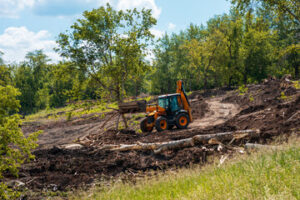Performing Land Clearing helps ensure safe and accessible construction sites for future projects. It also boosts a lot’s curb appeal by removing trash, overgrown shrubs, and other debris from the property.

This method involves cutting down trees and brush using specialized equipment. It can be done in an Eco-friendly manner by burning the vegetation or using chemicals.
Land Clearing involves removing dead vegetation such as trees, shrubs, weeds and brush from your property. This makes it easier for the remaining plants to get what they need like water and sunlight, which improves soil quality. It also helps prevent wildfires, as rotting branches and overgrown weeds can easily burn when exposed to sunlight.
Land clearing can also remove pest habitats. Pests, including mice, squirrels and termites, are attracted to areas with thick vegetation because it offers shelter. They can cause damage to your property and spread disease if not removed in time. Land clearing gets rid of these pests and other nuisance wildlife before they become a problem for you.
Overgrown areas can also create tripping hazards for pedestrians and vehicles. Branches from dying or overhanging trees may fall and hurt passersby during stormy seasons. They may even spread airborne diseases or viruses like mold that can affect your health and those of your family and pets. Land clearing keeps these hazards to a minimum by reducing the number of trees on your property and keeping the bushes, grass and undergrowth trimmed.
Before beginning, your contractor should do a thorough walk-through of the area you wish to clear and note important details like the type and density of vegetation. They should also inspect for any obstacles, such as rocks or hidden stumps. They will determine what kind of equipment and tools will be needed based on the size of the project and its complexity. They will also make sure the project is zoned and has all required permits before work begins.
There are several ways to perform land clearing, but the most popular is mechanical removal. This can be done with handheld tools or with heavy machinery, such as bulldozers and excavators. Herbicides are another option for land clearing, but they must be used correctly to ensure they don’t affect other vegetation or animals in the area. They can be very effective, but they aren’t ideal for areas with steep slopes or fragile ecosystems. Lastly, manual methods of clearing include mowing, mulching, burning and digging out unwanted vegetation.
Reducing Pest Populations
Dense areas of trees and vegetation offer pests natural shelter, boosting their populations. This is a significant problem in agricultural settings, where pests can damage crops and spread diseases that threaten human health and the environment. Land clearing can help reduce pest populations by removing their habitats.
For example, dense undergrowth is a popular hiding spot for ticks and other rodents that carry disease. Clearing this debris can dramatically reduce these hazards and make your property safer for construction, farming, or just enjoying the outdoors.
Additionally, rotting wood and other dead plants can attract pests like termites. Performing land clearing removes these potential infestations before they get out of control.
Clearing can also prevent soil erosion, a major concern for farmers and landowners. Erosion can rob soil of its nutrients, reducing crop yields and quality. In addition, it can contaminate nearby waterways with harmful pollutants or sediment. Land clearing can prevent erosion by creating barriers that shield the topsoil from the erosive forces of wind and water.
While destroying some vegetation is necessary for land clearing, the right plan can promote biodiversity and improve soil ecosystems. For example, removing invasive species and replacing them with native species can create habitats for beneficial insects and wildlife while supporting agriculture and food production.
When it comes to clearing land, the goal should be to prepare the site for a specific purpose. If your property is being cleared for construction or farming, you will need roads and open space to maneuver equipment and vehicles. Land clearing can also be used to create pathways and other features that can boost curb appeal and make your property more attractive to buyers or tenants.
Another benefit of land clearing is that it can help improve the overall landscape by removing weeds, fallen branches, and other debris. It is important to work with a professional team that has the proper experience and equipment to ensure safety and efficiency. Land clearing also allows you to plant more trees and plants on your property, which can enhance the overall look and increase its value.
Preventing Soil Erosion
Soil erosion is a serious problem that can be caused by many factors, including human activities. Over time, heavy equipment can scrape and wash away soil, and agriculture practices can leave the land devoid of ground-covering plants that hold soil in place. These issues can lead to loss of nutrients and water, which damages the environment and threatens the structural integrity of buildings and roads. Land clearing removes unwanted and overgrown vegetation to prevent these problems.
Another benefit of land clearing is pest control. Dense areas of trees and plants are ideal breeding grounds for mosquitoes, termites, squirrels, and other harmful pests. In addition, rotting wood attracts wildlife like bears and snakes that can pose safety threats to people and property. Land clearing eliminates the habitat of these pests, reducing their population and keeping them from infesting nearby structures.
Once the debris and vegetation are cleared, the land is graded, which levels the surface for construction or agricultural use. This process improves drainage and reduces the risk of flood damage and erosion. It also allows the land to retain more water, which promotes healthy vegetation and ecosystems.
Before construction, land clearing is a critical part of the preparation process for residential and commercial properties. Cleared land provides builders with a blank slate to work with, free from obstacles such as overgrown trees and thorny shrubs. Similarly, agricultural fields require clearing for proper cultivation and to improve access to sunlight and nutrients that are essential for plant growth.
Professionals who perform land clearing follow strict safety guidelines to protect workers and the environment. They have the experience and expertise to know which type of machinery is needed based on the size and condition of the land, and they understand how to minimize environmental impact while achieving the desired results. They also take into consideration local laws and regulations, such as zoning and environmental impact assessments, when planning the project. Lastly, they conduct a final inspection to ensure the land has been cleared correctly and is ready for its intended purpose. This includes ensuring that debris is properly disposed of, adequate grading has been done, and the required erosion control measures have been put in place.
Boosting Curb Appeal
Land Clearing can improve your property’s curb appeal by removing bushes and trees that block views, obstruct lawn and garden areas, or create shadows over outdoor living spaces. It can also be used to remove debris such as fallen branches, tripping hazards, or piles of firewood. A well-groomed, attractive yard makes a great first impression on guests and neighbors and demonstrates that your property is well-maintained. It is an inexpensive way to increase the overall look of your home and its surrounding land.
If you plan to sell your land in the future, it’s important to consider how potential buyers will see and use your property. A plot of land that is overgrown and covered in weeds, brush, or tree stumps will be much harder for people to imagine incorporating into their homes and gardens. Land clearing can open up a lot of space for gardening, building decks or patios, and other landscaping features that will increase your property’s value and appeal.
Aside from enhancing the aesthetics of your land, Land Clearing can be used to help with your property’s sustainability. Clearing land can reduce the amount of water that is lost to evaporation and improve soil conditions by allowing for proper drainage. In addition, it can make a property more accessible and less susceptible to environmental changes, such as flooding.
One of the most important benefits of Land Clearing is that it helps to prepare land for development and growth. It can be used to clear the land for construction, enabling builders and homeowners to create a vision for what can be done with the property. Whether the land is being used for building homes, an investment project, or even a new mall, a certain level of preparation must be made to ensure the safety and success of any new venture.
While most people associate Land Clearing with the massive removal of trees and other debris for a new shopping mall, hotel, or housing development, American Property Experts is more often called upon to perform smaller projects such as removing old fences, cleaning up ponds, or clearing brush around buildings. It is still important, however, for land owners to keep in mind the role that Land Clearing plays in shaping their property’s future, and how a little bit of work now can help make your property more valuable in the long run.

